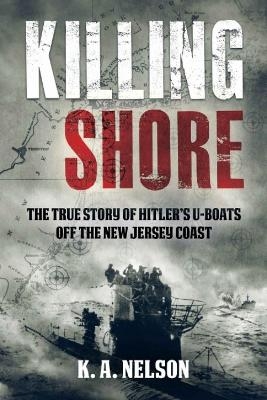
Killing Shore
The True Story of Hitler’s U-boats Off the New Jersey Coast
Seiten
2024
Casemate Publishers (Verlag)
978-1-955041-29-4 (ISBN)
Casemate Publishers (Verlag)
978-1-955041-29-4 (ISBN)
The shocking story of Nazi Germany’s naval assault in American waters, told through the eyes of seafarers who experienced it off the Jersey Shore.
It is January 1942/. Six weeks after the United States entered World War II, Imperial Japan is annihilating American forces across the Far East while the Nazis stand triumphant over much of Europe. Adolf Hitler’s forces are about to commence an assault along the East Coast of the United States, but this “Atlantic Pearl Harbor” would prove far more devastating than Japan’s attack on Hawaii. The wolves are closing in, and few Americans realize their beaches and coastal cities are about to witness the worst naval defeat in American history.
The Western Hemisphere holds the key to victory for the beleaguered Allies, but only if the vast economic and military resources of North and South America can be carried across the Atlantic by Allied merchant ships. These civilian-manned cargo vessels are the backbone of the American war economy and the lifeline enabling Britain and the Soviet Union to survive—but Hitler’s favorite admiral also knows this, and he has set in motion a plan of unprecedented boldness. Germany’s dreaded submarines, or “U-boats,” are going to the United States.
The fiery months that followed would pit American servicemen against German U-boat sailors in a desperate struggle that stained East Coast waters with oil and blood. In the crosshairs of this deadly cat-and-mouse game was a stalwart contingent of civilian mariners who crewed the tankers and freighters supplying the war against the Axis Powers. Thousands of them would perish as hundreds of merchant ships were sunk.
Every American coastal state became a battlefront in 1942, and the events that transpired off New Jersey illustrate the perils and brutality of this forgotten campaign. The seafloor along the Garden State is today strewn with shipwrecks that bear witness to the innumerable ways to die faced by friend and foe alike only miles from the boardwalk. Though these seafarers’ lives were forfeit, the battle they fought would decide the fates of millions.
It is January 1942/. Six weeks after the United States entered World War II, Imperial Japan is annihilating American forces across the Far East while the Nazis stand triumphant over much of Europe. Adolf Hitler’s forces are about to commence an assault along the East Coast of the United States, but this “Atlantic Pearl Harbor” would prove far more devastating than Japan’s attack on Hawaii. The wolves are closing in, and few Americans realize their beaches and coastal cities are about to witness the worst naval defeat in American history.
The Western Hemisphere holds the key to victory for the beleaguered Allies, but only if the vast economic and military resources of North and South America can be carried across the Atlantic by Allied merchant ships. These civilian-manned cargo vessels are the backbone of the American war economy and the lifeline enabling Britain and the Soviet Union to survive—but Hitler’s favorite admiral also knows this, and he has set in motion a plan of unprecedented boldness. Germany’s dreaded submarines, or “U-boats,” are going to the United States.
The fiery months that followed would pit American servicemen against German U-boat sailors in a desperate struggle that stained East Coast waters with oil and blood. In the crosshairs of this deadly cat-and-mouse game was a stalwart contingent of civilian mariners who crewed the tankers and freighters supplying the war against the Axis Powers. Thousands of them would perish as hundreds of merchant ships were sunk.
Every American coastal state became a battlefront in 1942, and the events that transpired off New Jersey illustrate the perils and brutality of this forgotten campaign. The seafloor along the Garden State is today strewn with shipwrecks that bear witness to the innumerable ways to die faced by friend and foe alike only miles from the boardwalk. Though these seafarers’ lives were forfeit, the battle they fought would decide the fates of millions.
K. A. Nelson is a US Marine Corps veteran and wreck diver. He resides near Philadelphia, Pennsylvania. See updates or contact him at KA-Nelson.com.
Preface
Sources & Methodology
Part I
1. Eins Zwei Drei
2. The Third Dimension of Warfare
3. The Gray Wolves
4. A Tide of Steel
Part II
5. Varanger
6. India Arrow
7. R.P. Resor
8. USS Jacob Jones (DD-130)
9. Gulftrade
10. Toltén
11. Persephone
12. Berganger
13. Rio Tercero
14. John R. Williams
15. Pan Pennsylvania
Part III
16. Wolfsdämmerung
17. Bones in the Ocean
Acknowledgments
Selected Bibliography
Endnotes
| Erscheinungsdatum | 01.03.2024 |
|---|---|
| Sprache | englisch |
| Maße | 152 x 229 mm |
| Themenwelt | Sachbuch/Ratgeber ► Geschichte / Politik ► Regional- / Landesgeschichte |
| Geschichte ► Allgemeine Geschichte ► 1918 bis 1945 | |
| Geschichte ► Teilgebiete der Geschichte ► Militärgeschichte | |
| Sozialwissenschaften ► Politik / Verwaltung | |
| ISBN-10 | 1-955041-29-6 / 1955041296 |
| ISBN-13 | 978-1-955041-29-4 / 9781955041294 |
| Zustand | Neuware |
| Informationen gemäß Produktsicherheitsverordnung (GPSR) | |
| Haben Sie eine Frage zum Produkt? |
Mehr entdecken
aus dem Bereich
aus dem Bereich
ein Psychologe erlebt das Konzentrationslager
Buch | Hardcover (2024)
Kösel (Verlag)
CHF 30,80
Mythos „Stauffenberg-Attentat“ – wie der 20. Juli 1944 verklärt und …
Buch | Hardcover (2024)
Goldmann (Verlag)
CHF 33,55


